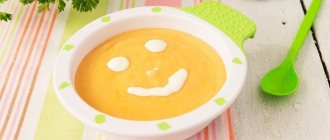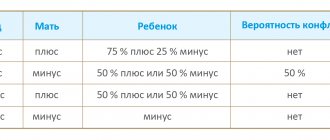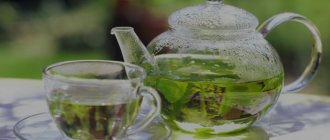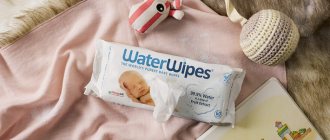Pros and cons of artificial feeding
WHO puts forward a requirement for formula manufacturers: to indicate on any product intended for baby food that the best food for a baby is mother's milk. However, maintaining breastfeeding is not easy. Often mothers complain that there is not enough milk or that the baby refuses to latch on to the breast. Then mixtures come to the rescue. But whether to start feeding newborns with formula and how much “artificial milk” to give is determined by the doctor.
The advantages of artificial feeding are obvious:
- Solving the problem of feeding a baby when it is impossible to carry out breastfeeding by medical means. mother's testimony.
- The ability to choose which formula to offer your baby.
- Daytime and nighttime formula feeding can be done in the absence of the mother.
- Artificial babies' sleep is stronger and longer, since the formula takes longer to digest than mother's milk.
- The daily routine of a bottle-fed baby is more stable than that of a breastfed baby. The hours of formula feeding are strictly defined.
There are also disadvantages:
- on any trip you need to take bottles and a pack of dry or liquid products;
- it is necessary to constantly sterilize a large number of containers;
- “maternal immunity” is not transmitted to the child, so the latter gets sick more often;
- It’s difficult to immediately decide which mixture to choose. Artificial feeding of infants is often accompanied by problems with the gastrointestinal tract, since it is difficult to choose a suitable adapted formula;
- high price for food.
Which formula to choose for a child
These food products can be classified in different ways. Before deciding which formula to choose for your newborn, consider all your options. According to the state of aggregation, food is divided into:
- dry. Can be stored for up to 3 weeks in an open package. Requires dilution with water;
- liquid. Use within 2-3 days after production. Supplied in a glass container or tetra pack.
Based on the proximity of the composition to mother’s milk, formulas are divided into:
- Adapted. Whey protein is used for production. The amount of nutrients and the ratio of proteins and fats are almost completely consistent with those found in breast milk. Suitable for babies from birth.
- Semi-adapted. More caloric. A special feature is the increased amount of iron, zinc and calcium in the composition.
- Unadapted. They are used from six months due to the presence of casein, which is poorly absorbed. Made from regular milk powder with the addition of various components.
Food is also classified depending on the permitted age of use.
A special mixture is offered to premature babies. It is marked with the number "0". For recently born babies, the marking “1” is used. The number “2” is printed on the food pack for children over six months of age. For a one-year-old child, formula number “3” is used.
The nutrition of a bottle-fed baby depends entirely on the parents, so the selection of a milk substitute must be approached with particular care. Before choosing a mixture, be sure to consult with your pediatrician.
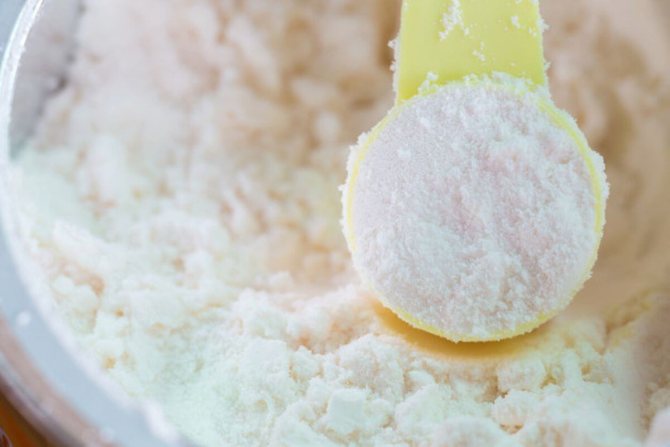
Formula for feeding newborns: how to prepare
If the child eats liquid formula, it is enough to pour it into a bottle and heat it to the required temperature. The dry product must be diluted according to the following rules:
- Use only specialized baby water. As a last resort - it has undergone a boiling procedure, cooled and filtered.
- Strictly follow the dosage indicated on the package to prevent over- and undernutrition.
- Make sure that the powder dissolves completely.
- Do not use “artificial milk” for repeated feeding.
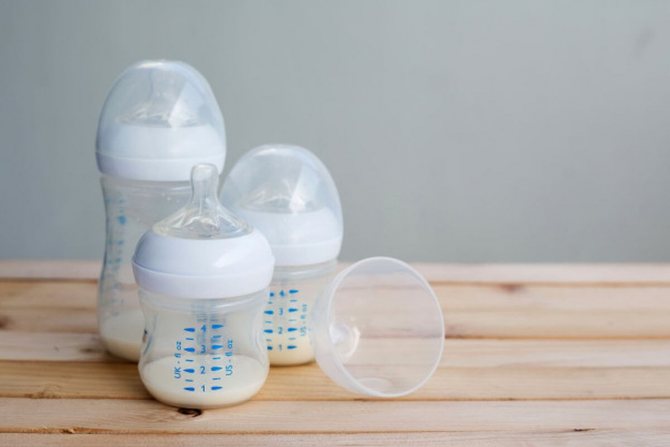
Feeding a baby with formula: features of the procedure
Particular attention is paid to the selection of bottles and pacifiers, without which a bottle-fed baby’s nutrition becomes impossible. The parameters of the “devices” for feeding are clearly defined:
- the volume of the bottle for children from 0 to 3 months does not exceed 150 ml;
- the nipple has an anatomical shape that prevents colic;
- The hole in the nipple is small, the baby must suck with some effort.
To feed the baby, the mother takes a position identical to that used during breastfeeding and gives the baby a bottle. There should be no air in the nipple when tilted.
At the end of feeding, the baby is held in a column, and the remaining mixture is poured out.
Baby bottle feeding chart
For babies who consume formula, a strict food intake regime is established. Typically, the manufacturer indicates the number of doses and the amount of product required on the package.
The general table of daily feeding dosage looks something like this:
| Age (months) | The volume of mixture used depending on the weight |
| up to 2 | 1/5 |
| from 2 to 4 | 1/6 |
| from 4 to six months | 1/7 |
| from six months to 8 | 1/8 |
| from 8 to one year | 1/9 |
It is better to calculate the exact consumption rate together with your pediatrician.

Mixed feeding: which mixture to choose and how to feed
If it is possible to give your child breast milk at least in minimal quantities, you should not refuse the opportunity.
This kind of nutrition is called mixed and is produced according to certain rules:
- the mother should stimulate lactation by using special pharmaceutical or natural remedies;
- the mixture is used only for supplementary feeding, the main food is breast milk;
- At night, the baby must be put to the breast;
- Pacifiers and bottles are given to the child as rarely as possible.
If possible, it is worth transferring the baby from mixed to breastfeeding.

How to transfer a child to artificial feeding
To make the transition easier for you and your baby, it's best to transition gradually. Try to start about a month before switching completely to formula feeding. This will allow your baby to gradually adjust to bottle feeding.
Warning! Remember, when choosing infant formula, you must consult a pediatrician. In no case do you decide this yourself, much less the consultant in the store.
How to introduce the mixture
To start, skip one breastfeeding, for example, the one that is most uncomfortable for you or when you have the least amount of milk, and replace it with a bottle. As your baby adjusts to the change in diet, gradually reduce the number of breastfeedings by one.
Until you reach your desired schedule. For example, you can breastfeed your baby in the morning and before bed, and give him formula in between those feedings.
What to do if your child refuses the bottle
Try experimenting with different brands of bottles and nipples until you find one that suits your baby. You can also ask someone else (husband or relative) to feed the baby. Since your baby, feeling the smell and warmth of the mother's breast, may refuse the bottle.
Another option is to feed him when he is not too tired or hungry, then the baby will not become so nervous.
Note. If you plan to continue breastfeeding and use formula as a complementary food, you will need to wait until your baby is at least 3-4 weeks old before introducing a bottle.
Have the right attitude
For many moms, the idea of switching to formula feeding means losing the closeness they share with their baby. But this is a mistaken opinion. When you offer the bottle, you can hold your baby close in your arm, look him in the eyes, and speak or sing softly.
What rules should you follow during a sudden transition?
- For the first couple of days (2-3), give a slightly smaller amount of food than usual. Approximately 2/3 of the volume, supplementing the missing amount with warm and weak tea.
- Make sure that your baby always receives enough fluid.
- Do not keep your baby on limited feeding for a long time. If the prescribed mixture is well tolerated, its amount must be brought to normal within 3-5 days.
- When a baby switches to artificial feeding, careful monitoring by the pediatrician of the baby’s health is necessary, especially the first days of adaptation to infant formula.
Conclusion
We know for sure that the breast is best for feeding your baby. But there are many situations where “best” is simply not an option. Deciding which is better - breastfeeding or bottle-feeding a child is a personal choice for each mother.
There are many reasons why a woman might choose to breastfeed. Therefore, no one should question her decision or make her feel guilty.
For medical reasons, I also bottle-fed my daughter. Moreover, when there was not such an abundance of baby formula and such quality around. I, like many women, wanted to be an “ideal mother.” And while artificially feeding a baby doesn’t make anyone a bad mom, I still felt “guilt” every time I gave my daughter a bottle.
Now that she has grown up and, looking back, I can say for sure that it is possible to raise a child healthy even with artificial feeding. Being a mother is more than breastfeeding. What makes you a good mother is the love and attention you show to your child.
I recommend looking at what L. N. Safronova, Associate Professor of the Department of Neonatology and Neonatal Reanimation of St. Petersburg State Medical University, advises to pay attention to when artificial feeding.
Do I need to add more solder?
Breastfeeding babies receive enough fluid from their mother's milk. But even they in some cases must necessarily drink water:
- in case of illness, especially accompanied by fever;
- in summer;
- with difficulty passing stool.
If artificial feeding of newborns is used, the above rules are also followed.
Babies are spoon fed using special baby water, boiled or filtered liquid. The procedure is performed after eating.

Rules for babies
The most physiological food for infants is mother's milk. Its temperature (about 37°C) is close to both the body temperature of a nursing woman and the intrauterine temperature to which the baby has become accustomed during the 9 months of gestation. And if a child is fed an artificial formula, you need to carefully monitor the temperature to make it as similar as possible to breast milk. This will ensure normal functioning of the digestive organs and complete absorption of nutrients.
If the mixture is cold, the baby’s body will have to spend energy on warming up, which means energy consumption will increase, which can lead to delayed growth and development of the baby. To heat the mixture, diluted and poured into a bottle, you can immerse it in warm water at the appropriate temperature or use a special heater. Before feeding, check if it is too hot by dropping a drop on the back of your wrist.
